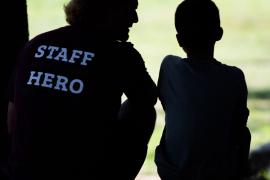Many years ago, before social media, electric cars, and the smartphone, a little boy went to camp. He had overcome tremendous hurdles before ever stepping foot on a campground.
In fact, at the ripe old age of three, he had fought for his life on an operating table, and for a year after that he had received monthly chemotherapy treatments, blood transfusions, and radiation a thousand miles from home.
But camp was a place where he fit in. There he enjoyed free play with his buddies, and his differences were celebrated. He packed his bags with all his favorite T-shirts and a special blanket, anticipating all the fun he would have with his cabinmates and counselors. Archery was a favorite, but gold panning made his heart sing.
However, as time went on, this little boy faced more and more challenges. His behavior worsened with each passing year, behavior that stemmed from the terror and trauma of extended hospital stays and isolation during his cancer treatment. There were evaluations and diagnoses, and he slowly became “that kid.” The problem kid. The behavior issue.
He grew angry and sullen, and who could blame him? Life had dealt him a tough hand. But camp had always been an oasis in the middle of a hurricane — until his counselors, highly trained veteran staff, no longer felt equipped to manage his behavior.
When a camper’s behavior is so disruptive to the culture and expectations set in the cabin, how do you help restore balance? Some campers’ behavior may just be too much to handle, and camp may not be the best place for them. But how can you assess behaviors and de-escalate a problem when it is necessary rather than calling leadership for every behavior issue that occurs?
We all hope that our campers will experience the joy, camaraderie, and empowerment that camp offers.
But what do you do when difficult behaviors get in the way?
Even as program staff with no clue how to manage an emotional outburst or unexpected defiance, we understand the panic, the breaking into a cold sweat even in the middle of a sweltering July day when a camper decides to jump into a kayak without a lifejacket or yell in a fellow cabin mate’s face in the dining hall.
Fortunately, all you need to learn is how to decode a child’s behavior formula. The ABC model is a very simple behavior formula you can use. This model comes from Applied Behavioral Analysis and is an incredible tool for anyone caring for children at camp. Once you learn how to do this, you will find that how to manage behavior makes so much sense.
The first thing to decode is the “A” of our ABC, which stands for Antecedent and is just a fancy way of saying “everything that comes before the behavior.” Look for the triggers in the environment right before a camper’s specific disruptive behavior. To be thorough, you want to look for the environment’s who, what, where, and when.
- Who was around?
- What was said and done?
- Where was the camper?
- When did it happen?
Answering these questions will help you zero in on what is triggering the behavior.
Once you know the antecedents (aka everything before the behavior), you can troubleshoot. What can you add to the environment or take away from the environment to support better behavior from this camper? For example, does this camper have explosive behavior right before dinner? Could this mean that their behavior is being triggered by hunger or low blood sugar? Would a protein-rich snack before dinner be helpful? This is an example of things to consider once you have uncovered the A of the formula.
The “B” of the ABC stands for “Behavior and Behavior Motivation.” After the Antecedent comes the Behavior, and every one of these behaviors is motivated by a person’s wants or needs. Ultimately, behavior is communication, so this is the part of the formula where we try to understand what a camper is trying to communicate to us. What do they want or need?
The three types of behavior motivations that we will focus on are:
Escape — a child wants to stop doing something or leave a situation. For example, a camper who is afraid of water throws a tantrum before the swim test so she can escape the test.
Tangibles — anything physical; anything that can be touched. For example, a camper screams when he doesn’t get to have mac and cheese for lunch and won’t calm down until you ask the chef to make a special plate for him.
Attention — when we talk about attention, we mean focused, quality attention from a specific person. For example, a new camper comes to camp for the first time with her best friend. Whenever the friend is having fun with other campers, the new camper starts telling inappropriate jokes to try to get the attention of her friend and anyone else who will listen.
Once you know a child’s behavior motivation, you can start meeting that child’s wants or needs even before the behavior arises. If a camper loves spending time with your co-counselor (attention), you might plan more quality time with that counselor. If a camper enjoys playing on the playground (tangibles), you might add in more playground time for this camper. If a camper is afraid of snakes on the path from archery to swimming (escape), perhaps you can find a different route to avoid a place that feels scary.
The final part of our decoding formula, the C of the ABC, stands for “Consequences.” This refers to anything that happens after a camper’s action. Observe what happens after a camper’s disruptive behavior. Some questions you can ask yourself are:
- How do I respond to this camper’s behavior?
- How do others respond to this camper’s behavior?
From research, we know that reinforcements are far more effective than punishments when trying to change behavior. So, once you have observed the camper’s kind of behavior, you can choose a consequence based on their motivation:
- Attention — choose quality attention from a specific person as this camper’s reinforcement.
- Escape — let the child get out of a situation as their reinforcement.
- Tangibles — choose a favorite item or activity as the camper’s reinforcement.
Once you’ve observed all the parts of a camper’s behavior formula, you can put this reinforcement into action by communicating expectations. Explain to your camper what you expect of them and what they will earn when they do what you’ve asked them to do. For example:
- “If you do [correct behavior], then you will get [reinforcement].”
- “If you do not do [correct behavior], you will not get [reinforcement].”
Putting this into practice could look like this: “If you use kind words with your cabinmates for the next 15 minutes, then you will get to choose a candy of your choice. If you do not use kind words with your cabinmates for the next 15 minutes, you will not get to choose a candy of your choice, and we will try again.”
After you’ve communicated expectations, follow through consistently with the consequences you have set. Simply put, this means:
- If your camper does what you ask, praise them and give them their reward/reinforcement right away.
- If your camper does not do what you ask or behaves disruptively, do not reinforce their behavior, meaning do not give them what they are seeking with their behavior. But do try again until they do what you’ve asked them to.
So, let’s look at a couple of camper scenarios.
Meet Sam. Sam has attended camp for years. This year, you notice that whenever it is time to clean the cabin, Sam disappears to the bathroom. You also notice this behavior in the dining hall after the meal is over. Finally, after you see it again during an arts and crafts activity, you remind Sam that he must help clean up.
Let’s decode Sam’s behavior formula.
- Antecedent: When Sam is asked to clean.
- Behavior and Behavior Motivation: The specific problem behavior that we want to help Sam manage is his running away to avoid cleaning. Sam’s behavior motivation is very clearly escape.
- Consequence: You and your co-counselors try to help settle Sam down, while others do the cleaning task.
Now that we have decoded Sam’s behavior formula, we can add or subtract variables, just like we would in a math problem.
If you want a new solution to the problem, you have to change the equation. You can change your A (Antecedent) or your C (Consequence). In an environment like summer camp, changing the consequence is the fastest and easiest way to change behavior. To help Sam, you could choose to define the amount of cleaning he does and give him a positive reinforcement that is easy and effective for Sam. For example:
- “If you wipe the tables after dinner, then you can have 15 extra minutes on the playground when you’re finished.”
- “If you do not wipe the tables after dinner, then you cannot have 15 extra minutes on the playground after dinner.”
If Sam does what you ask, you can praise him and take him to the playground right away. If Sam does not do what is asked, you should ignore any disruptive behavior and ask Sam to try again.
Elaine is a first-time camper at your camp. On her forms, her mother mentioned that her favorite activity is making bracelets. When Elaine’s cabin visits the arts and crafts room, she heads straight to the bead area and starts crafting her bracelets. Things go fine until it is time to leave. When everyone starts cleaning up, Elaine continues making bracelets. You tell her she needs to clean up, and Elaine tells you she would like to stay for a little longer. You tell her about archery, which is the next activity, but Elaine says she hates archery. She eventually cleans up but walks away from the group and won’t speak to anyone. When your group gets to archery, she refuses to participate. This behavior continues for the next activity and during rest time. One of her other counselors gets some bracelet-making supplies to use in the cabin. Elaine’s attitude and behavior means the focus within the group is mostly on Elaine, and the other girls in the cabin are frustrated by her behavior.
Let’s decode Elaine’s behavior formula and see what’s really happening.
- Antecedent: Anytime Elaine does not have access to her bracelet-making activity.
- Behavior and Behavior Motivation: The specific problem behavior we want to help Elaine manage is isolating herself and having a negative attitude. Her behavior motivation is tangibles — her bracelet craft supplies.
- Consequence: Your co-counselors try to coax Elaine into joining in other camp activities and also offer her bracelet supplies.
Understanding Elaine’s behavior formula, how could you change her behavior’s consequence to help her? What if you structured her day so that bracelet-making could be offered at different times of the day? You might carry bracelet supplies with you during the day to do at different times and places. You could discuss with Elaine that after she tries a new activity for x minutes, she can then have access to her bracelet-making stuff for the remainder of the activity period.
You could explain your new expectations for Elaine when the cabin is participating in activities other than arts and crafts as follows:
- “If you participate in this activity for 15 minutes with a positive attitude, then you can have 15 minutes at the end of this activity period to make bracelets.
- “If you do not participate for 15 minutes with a positive attitude, then you cannot have 15 minutes at the end of the activity period to make bracelets.”
If Elaine does what you ask, praise her and give her time to work on her bracelets. If she does not do what is asked, ignore any disruptive behavior, like a negative attitude, and ask Elaine to try again so she can earn her bracelet craft time.
By decoding your campers’ behavior formulas, you will be able to step in at a moment’s notice, assess the situation quickly, and help your campers have a camp experience that they love and remember for the rest of their lives.
For a free guide for camp staff, visit pages.jsparentcoaching.co/camp-free-guide.
Photo courtesy of Camp Fire Alaska's Rural Alaska Program, Anchorage, AK.
Jamie Ekstrom, M Ed, is a camp program director at Camp Sunshine, and has previously led ACA award-winning camp programs for children with autism and children of wounded warriors. He has also worked as a behavior tech at one of the nation’s leading autism centers. Sophie Ekstrom has worked as a teacher and preschool extended day program coordinator at one of the nation’s top private schools for preschool and elementary-age children with speech and language delays. Before she was a teacher, she worked as the arts and music director at a camp for kids with special needs and life challenges. Jamie and Sophie now utilize their backgrounds in camp and education to train camp professionals and camp staff in effective behavior management strategies.



